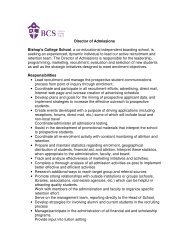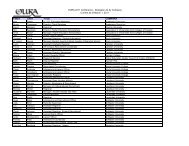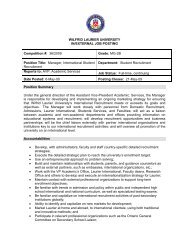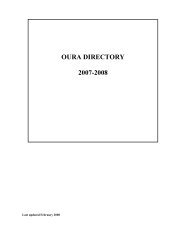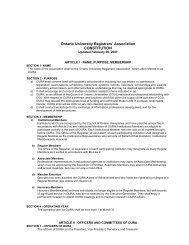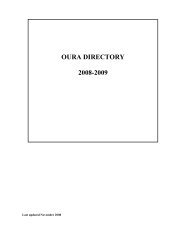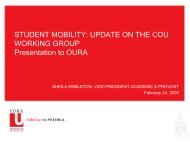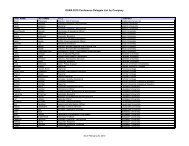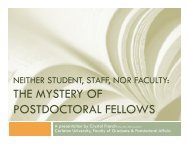STRATEGIC ENROLLMENT MANAGEMENT Core Concepts and ...
STRATEGIC ENROLLMENT MANAGEMENT Core Concepts and ...
STRATEGIC ENROLLMENT MANAGEMENT Core Concepts and ...
You also want an ePaper? Increase the reach of your titles
YUMPU automatically turns print PDFs into web optimized ePapers that Google loves.
OURA<br />
Ottawa 2009<br />
Leadership Workshop:<br />
Strategic Enrolment Management 101<br />
OURA Conference<br />
Ottawa<br />
February 23, 2009<br />
© Gottheil, Smith<br />
1
OURA<br />
Ottawa 2009<br />
Presenters<br />
Susan Gottheil, M.A.<br />
Associate Vice-President, Enrolment Management<br />
Mount Royal College, Calgary, Alberta, Canada<br />
Senior Consultant, AACRAO Consulting<br />
sgottheil@mtroyal.ca<br />
Clayton Smith, Ed.D.<br />
Vice-Provost, Students & Registrar<br />
University of Windsor, Ontario, Canada<br />
Senior Consultant, AACRAO Consulting<br />
csmith@uwindsor.ca<br />
© Gottheil, Smith<br />
2
OURA<br />
Ottawa 2009<br />
Outline<br />
‣ Morning Session:<br />
• SEM Audit<br />
• Develop a common underst<strong>and</strong>ing of SEM<br />
• SEM implementation challenges<br />
‣ Afternoon Session:<br />
• Applying SEM through case studies focused on<br />
enrolling First -Generation students in Ontario<br />
- Recruitment case study<br />
- Student success case study<br />
© Gottheil, Smith<br />
3
OURA<br />
Ottawa 2009<br />
Materials<br />
‣ PowerPoint presentation<br />
‣ SEM Audit<br />
‣ Article on Canadian vs. U.S. SEM<br />
‣ SEM Plan Web Sites<br />
‣ Bibliography<br />
www.uwindsor.ca/sem<br />
4<br />
© Gottheil, Smith
OURA<br />
Ottawa 2009<br />
SEM Audit<br />
© Gottheil, Smith<br />
5
OURA<br />
Ottawa 2009<br />
What is Strategic Enrolment<br />
Management?<br />
© Gottheil, Smith<br />
6
OURA<br />
Ottawa 2009<br />
Strategic enrollment management (SEM)<br />
is a concept <strong>and</strong> process that enables the<br />
fulfillment of institutional mission <strong>and</strong><br />
students’ educational goals.<br />
-Bob Bontrager<br />
© Gottheil, Smith<br />
7
OURA<br />
Ottawa 2009<br />
SEM Started in the U.S.<br />
‣ Started in the late 1970’s at Boston College<br />
• As a result of declining traditional student<br />
enrolments<br />
‣ Early focus on attracting new students (e.g.,<br />
returning adults, women, minorities, lowincome)<br />
‣ Exp<strong>and</strong>ed to all types of PSE institutions<br />
(e.g., public, private, 2-year, 4-year, grad)<br />
© Gottheil, Smith<br />
8
OURA<br />
Ottawa 2009<br />
SEM Started in the U.S. (Cont’d)<br />
‣ Grew to include student success<br />
• First-Year Experience programs<br />
• Increased levels of student engagement<br />
‣ Increasing emphasis on connecting with<br />
institutional financial management<br />
‣ Now the concern of the senior leadership<br />
team – presidents, provost, deans<br />
© Gottheil, Smith<br />
9
OURA<br />
Ottawa 2009<br />
Emergence of SEM in Canada<br />
‣ Slower emergence of SEM in Canada<br />
‣ Driven by funding cuts, lack of revenue, heavier<br />
reliance on tuition, changing demographics<br />
‣ Many Canadian institutions have now adopted<br />
SEM in name, practice or both<br />
• We’re attending webinars, workshops & conferences<br />
• Some of us are working with consultants<br />
© Gottheil, Smith<br />
10
OURA<br />
Ottawa 2009<br />
© Gottheil, Smith<br />
11
OURA<br />
Ottawa 2009<br />
A Few <strong>Core</strong> <strong>Concepts</strong><br />
© Gottheil, Smith<br />
12
OURA<br />
Ottawa 2009<br />
The Purposes of SEM are Achieved<br />
by…<br />
‣ Establishing clear goals for the number <strong>and</strong> types<br />
of students needed to fulfill the institutional mission<br />
‣ Promoting students’ academic success by<br />
improving access, transition, persistence, <strong>and</strong><br />
graduation<br />
‣ Promoting institutional success by enabling<br />
effective strategic <strong>and</strong> financial planning<br />
© Gottheil, Smith<br />
13
OURA<br />
Ottawa 2009<br />
The Purposes of SEM are Achieved<br />
by…<br />
‣ Creating a data-rich environment to inform<br />
decisions <strong>and</strong> evaluate strategies<br />
‣ Improving process, organizational <strong>and</strong> financial<br />
efficiency <strong>and</strong> outcomes<br />
‣ Strengthening communications <strong>and</strong> marketing<br />
with internal <strong>and</strong> external stakeholders<br />
‣ Increasing collaboration among departments<br />
across the campus to support the enrollment<br />
program<br />
© Gottheil, Smith<br />
14
OURA<br />
Ottawa 2009<br />
The Concept of Optimum Enrollment<br />
Ethnicity<br />
Physical<br />
Capacity<br />
Majors<br />
Academic<br />
Profiles<br />
Institutional<br />
Mission<br />
Undergrad/<br />
Grad<br />
International<br />
Special<br />
Skills<br />
Program<br />
Capacity<br />
© Gottheil, Smith<br />
15
OURA<br />
Ottawa 2009<br />
The Student Success Continuum<br />
‣ Traditional Enrollment Perspective<br />
Recruitment/<br />
Marketing<br />
Admission<br />
Orientation<br />
Financial<br />
Support<br />
Classroom<br />
Experience<br />
Academic<br />
Support<br />
Co-curricular<br />
Support<br />
Student’s College Career<br />
Retention<br />
Attain<br />
Degree/Goal<br />
© Gottheil, Smith<br />
16
OURA<br />
Ottawa 2009<br />
The Student Success Continuum<br />
‣ The SEM Perspective<br />
Recruitment/<br />
Marketing<br />
Orientation<br />
Classroom<br />
Experience<br />
Student’s College Career<br />
Co-curricular<br />
Support<br />
Attain<br />
Degree/Goal<br />
Admission<br />
Financial<br />
Support<br />
Academic<br />
Support<br />
Retention<br />
© Gottheil, Smith<br />
17
1<br />
OURA<br />
Ottawa 2009<br />
SEM Planning Model<br />
Meeting<br />
Goals<br />
Typical starting<br />
point<br />
Tactics<br />
Strategies<br />
DATA<br />
Enrollment Infrastructure<br />
Structure, Staffing, Skills, Systems, Service<br />
Clear Mission <strong>and</strong> Goals<br />
Starting point for<br />
long term<br />
success<br />
© Gottheil, Smith<br />
18
Slide 18<br />
b1 bontragr, 5/7/2005
OURA<br />
Ottawa 2009<br />
Creating a Data-Driven Enrolment Plan<br />
The Enrolment<br />
Data Agenda<br />
Alumni<br />
Research<br />
Placement Data<br />
Graduate Rates<br />
Retention Data<br />
Student Surveys<br />
Financial Aid Analysis<br />
Yield Data<br />
Admission Statistics<br />
Competitive Analysis<br />
Market Research<br />
Active<br />
Alumni<br />
Graduated<br />
Engaged,<br />
Satisfied<br />
Retained<br />
Enrolled<br />
Deposited<br />
Applied/Admitted<br />
Prospective Students<br />
Enrolment Strategies<br />
Alumni<br />
engagement<br />
Graduation/<br />
Career Development<br />
First Year Exp. &<br />
Retention Programs<br />
Yield<br />
Recruitment<br />
Marketing<br />
© Gottheil, Smith<br />
19
OURA<br />
Ottawa 2009<br />
The Enrolment Funnel is Different for<br />
Different Students<br />
Student Type:<br />
•New Immigrants<br />
•International Students<br />
•First-Generation Students<br />
•Rural Students<br />
•Students with Disabilities<br />
•Dislocated Workers<br />
•Sole Support Mothers<br />
•Low-income Students<br />
•Minority Students<br />
•High-Achieving Students<br />
© Gottheil, , Smith<br />
20
OURA<br />
Ottawa 2009<br />
A Few Ways to Look at SEM<br />
© Gottheil, , Smith<br />
21
OURA<br />
Ottawa 2009<br />
“Capacity Development Loop”<br />
“Delivery Loop”<br />
=<br />
+<br />
+<br />
Programs &<br />
Courses Offered<br />
+<br />
+<br />
+<br />
Courses<br />
Taught<br />
+ or -<br />
+<br />
Gov’t<br />
Approval For<br />
Credit<br />
Programs<br />
Programs &<br />
Courses Developed &<br />
Approved<br />
=<br />
+<br />
+<br />
+<br />
Dem<strong>and</strong> for<br />
Programs &<br />
Courses<br />
Tuition &<br />
Other Sources<br />
Of Revenue<br />
+<br />
+<br />
Courses<br />
Enrolled<br />
+<br />
Reasons<br />
For Not<br />
Continuing<br />
Student<br />
Retention<br />
-<br />
+<br />
+<br />
Student<br />
Attrition<br />
Programs &<br />
Courses<br />
Completed<br />
=<br />
Students Graduated,<br />
Transferred, Hired<br />
+<br />
Gov’t Grants<br />
& External<br />
Funding<br />
=+<br />
Source: P. Seto, 2008<br />
© Gottheil, , Smith<br />
22
OURA<br />
Ottawa 2009<br />
Enrolment Management System<br />
Student<br />
Characteristics<br />
Environmental<br />
Factors<br />
Institutional<br />
Goals<br />
Institutional<br />
Objectives<br />
Institutional<br />
Strategies<br />
Desired<br />
Outcomes<br />
Enduring<br />
Effect<br />
Enduring<br />
Behaviour<br />
Member of<br />
underserved<br />
student group<br />
Beliefs &<br />
values<br />
Academic<br />
preparation<br />
Motivation to<br />
learn<br />
Educational<br />
aspirations<br />
Self-discipline<br />
Adaptability<br />
Interpersonal<br />
skills<br />
Peer<br />
involvement<br />
Ability to pay<br />
Study habits<br />
Family & peer<br />
Support<br />
Student<br />
enrolment<br />
behaviour<br />
Demographic<br />
trends<br />
Competition<br />
Public<br />
Accountability<br />
(loan default<br />
rate,<br />
graduation,<br />
Accessibility,<br />
retention)<br />
Student<br />
geographic<br />
draw<br />
Economic<br />
Trends<br />
Off-campus<br />
employment<br />
availability<br />
Federal &<br />
provincial<br />
polices<br />
Quantitative<br />
Goals<br />
Qualitative<br />
Goals<br />
Diversity<br />
Goals<br />
Persistence<br />
Goals<br />
Capacity<br />
Goals<br />
Net Revenue<br />
Goals<br />
Student<br />
headcount<br />
Admission average<br />
Transfer GPA<br />
Visible minorities,<br />
Aboriginal,<br />
international<br />
Retention rates,<br />
Student<br />
Satisfaction,<br />
graduation rates<br />
Classroom<br />
capacity,<br />
adequate sections,<br />
Class size<br />
Financial aid<br />
discount rate,<br />
international<br />
enrolment<br />
•Marketing<br />
•Recruitment<br />
•Admission<br />
•Financial<br />
aid/pricing<br />
•Orientation<br />
•Residence<br />
•Athletics<br />
•First Year<br />
•Experience<br />
•Advising<br />
•Supplemental<br />
instruction<br />
•Service<br />
learning<br />
•Learning<br />
communities<br />
•Academic<br />
support<br />
•Peer support<br />
•Teaching &<br />
learning<br />
approaches<br />
•Student<br />
engagement<br />
•SEM<br />
organization<br />
•Data mining<br />
Awareness<br />
Interest<br />
Commitment<br />
Enrolment<br />
Persistence<br />
Satisfaction<br />
Education<br />
Relationship<br />
Institutiona<br />
l<br />
Loyalty<br />
Institutional<br />
Image<br />
Adapted from: Kuh et al , 2007; Black, 2003<br />
© Gottheil, , Smith<br />
23
OURA<br />
Ottawa 2009<br />
© Gottheil, , Smith<br />
24
OURA<br />
Ottawa 2009<br />
What SEM is Not<br />
‣ A quick fix<br />
‣ Solely an organizational structure<br />
‣ An enhanced admission & marketing operation<br />
‣ A financial drain on the institutional budget<br />
‣ An administrative function separate from the<br />
academic mission of the institution<br />
© Gottheil, , Smith<br />
25
OURA<br />
Ottawa 2009<br />
Institutional Mission &<br />
Enrolment Goals Are Determined By:<br />
Current<br />
competitive<br />
status<br />
Weaknesses<br />
Historical<br />
status<br />
Programs<br />
offered<br />
Niche<br />
Strengths<br />
Range of<br />
influence<br />
Aspirational<br />
status<br />
© Gottheil, , Smith<br />
26
OURA<br />
Ottawa 2009<br />
© Gottheil, , Smith<br />
27
OURA<br />
Ottawa 2009<br />
Determine your<br />
niche, focus on it,<br />
<strong>and</strong> deliver on it as<br />
well as you possibly<br />
can . . .<br />
© Gottheil, , Smith<br />
28
OURA<br />
Ottawa 2009<br />
Enrolment Goals:<br />
The Classic Conundrum<br />
‣ All may want better students<br />
‣ Administration may want more<br />
students<br />
‣ Faculty usually want fewer students<br />
‣ Access vs. Quality<br />
Adapted from Henderson<br />
© Gottheil, , Smith<br />
29
OURA<br />
Ottawa 2009<br />
A Re-Cap: Major SEM Components<br />
‣ Accessibility<br />
‣ Accountability<br />
‣ Admission Policies<br />
‣ Financial Aid<br />
‣ Geographic Draw<br />
‣ Enrolment<br />
Marketing<br />
‣ Organization<br />
‣ Planning<br />
‣ Recruitment<br />
‣ Retention<br />
© Gottheil, , Smith<br />
30
OURA<br />
Ottawa 2009<br />
SEM Implementation Challenges:<br />
How Do You Make It Work?<br />
© Gottheil, , Smith<br />
31
OURA<br />
Ottawa 2009<br />
Leadership Workshop:<br />
Strategic Enrolment<br />
Management 101<br />
Part II: Using SEM<br />
to Recruit & Retain<br />
First-Generation<br />
Students<br />
© Gottheil, , Smith<br />
32
OURA<br />
Ottawa 2009<br />
Enrolment Management<br />
Enrollment management is an organizational concept <strong>and</strong> a<br />
systematic set of activities designed to enable educational<br />
institutions to exert more influence over their student<br />
enrollments. Organized by strategic planning <strong>and</strong> supported<br />
by institutional research, enrollment management activities<br />
concern student college choice, transition to college, student<br />
attrition <strong>and</strong> retention, <strong>and</strong> student outcomes. These<br />
processes are studied to guide institutional practices in the areas<br />
of new student recruitment <strong>and</strong> financial aid, student support<br />
services, curriculum development <strong>and</strong> other academic areas<br />
that affect enrollments, student persistence <strong>and</strong> student outcomes<br />
from college.<br />
- Don Hossler, 1990<br />
© Gottheil, , Smith<br />
33
OURA<br />
Ottawa 2009<br />
First-Generation Students<br />
‣ Parental education (& not parental income) key<br />
drive of PSE participation in general &<br />
university in particular (Finnie & Mueller, 2008)<br />
‣ Definition: Who are “first-generation”<br />
students?<br />
‣ How do we identify them?<br />
‣ Is your institution targeting them<br />
• access/recruitment?<br />
• retention?<br />
• services?<br />
© Gottheil, , Smith<br />
34
OURA<br />
Ottawa 2009<br />
Access of First-Generation<br />
Students<br />
‣ 81% of 18 to 24 year olds whose parents have<br />
a university education participate in PSE,<br />
compared to 53% for young people whose<br />
parents didn’t go past high school (CMSF)<br />
‣ 1 st generation students in Ontario are 2.4<br />
times less likely to attend PSE (MTCU, 2008)<br />
© Gottheil, , Smith<br />
35
OURA<br />
Ottawa 2009<br />
Barriers to Access<br />
‣ Financial<br />
• Tuition, fees & cost of living<br />
• Debt aversion<br />
‣ Academic<br />
• Low high school grades, wrong course prerequisites,<br />
high dropout rate<br />
• Lack of preparation (hard & soft skills); quality of<br />
local high schools<br />
• Gaps in training <strong>and</strong> certification<br />
‣ Geographic<br />
• Distance, costs of travel<br />
© Gottheil, , Smith<br />
36
OURA<br />
Ottawa 2009<br />
Barriers to Access (cont’d)<br />
‣ Language & literacy<br />
‣ Family* & community*<br />
• Lack of role models<br />
* However, some ethnic groups have considerably<br />
higher educational aspirations for their children<br />
than others<br />
‣ Enforced cultural assimilation <strong>and</strong> legacy of<br />
residential school system for Aboriginal<br />
students<br />
• Distrust of non-Aboriginal institutions<br />
© Gottheil, , Smith<br />
37
OURA<br />
Ottawa 2009<br />
Barriers to Access (cont’d)<br />
‣ Aspirational<br />
• Lack of interest/motivation<br />
• PSE not considered necessary (for job, life)<br />
• Lack of information about PSE options & benefits<br />
‣Self-esteem <strong>and</strong> self-confidence<br />
‣Institutional<br />
• Programs don’t respond to needs, interests<br />
• Unknown environment<br />
• Admission criteria <strong>and</strong> complexity of admission<br />
procedures<br />
• Lack of information<br />
• Counseling structure<br />
© Gottheil, , Smith<br />
38
OURA<br />
Ottawa 2009<br />
First-Generation Students: Access<br />
‣ You are tasked with developing a SEM action<br />
plan to increase enrolment of first-generation<br />
students<br />
• How would you approach this task?<br />
• Who would you work with?<br />
• What would you include in the Plan?<br />
‣ Real-life pitfalls & challenges of recruiting firstgeneration<br />
students<br />
© Gottheil, , Smith<br />
39
OURA<br />
Ottawa 2009<br />
Campus Experience of<br />
First-Generation Students<br />
‣ NSSE (2008): About half not involved in<br />
extracurricular activities<br />
‣ College Board (U.S.): Less likely than peers<br />
to earn degrees, even when differences in<br />
high-school preparation taken into account<br />
© Gottheil, , Smith<br />
40
OURA<br />
Ottawa 2009<br />
Attrition Factors<br />
‣ Academic preparation <strong>and</strong> performance<br />
• Contributes to lack of engagement, motivation<br />
• Questioning of abilities, confidence<br />
‣ Financial support<br />
‣ Family <strong>and</strong> work responsibilities<br />
‣ Language proficiency<br />
© Gottheil, , Smith<br />
41
OURA<br />
Ottawa 2009<br />
Attrition Factors (cont’d)<br />
‣ Low level of educational<br />
aspiration/motivation<br />
‣ Well-being<br />
• Isolation<br />
• Stress<br />
• Lack of underst<strong>and</strong>ing of culture, racist attitudes<br />
on campus<br />
‣Social/Family/Community support<br />
© Gottheil, , Smith<br />
42
OURA<br />
Ottawa 2009<br />
First-Generation Students:<br />
Retention<br />
‣ You are tasked with developing a SEM action<br />
plan to increase the retention of first-generation<br />
students<br />
• How would you approach this task?<br />
• Who would you work with?<br />
• What would you include in the Plan?<br />
‣ Real-life pitfalls & challenges of retaining firstgeneration<br />
students<br />
© Gottheil, , Smith<br />
43
OURA<br />
Ottawa 2009<br />
Summary<br />
‣ Web of barriers to access & success<br />
interact with & compound one<br />
another<br />
• Unmet financial need<br />
• Inadequate academic preparation, motivation &<br />
direction<br />
• Insufficient information, guidance &<br />
encouragement<br />
‣ Utilizing a comprehensive, SEM framework<br />
essential to meeting institutional goals<br />
© Gottheil, , Smith<br />
44
OURA<br />
Ottawa 2009<br />
© Gottheil, , Smith<br />
45



